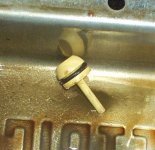Sorry, I didn't realize there was a question.Anyone?
Are you doing this with the engine still in the vehicle? Not saying it can't be done, but I can't imagine any other way worse.
To answer your question, it is difficult to say from the pic if the crankshaft keyway is properly located... I would need to refer to the the block/head assembly on an engine stand I use for mock ups.
Presumably, the number one piston appears to be near Top Dead Center, but without the remaining components installed and properly timed, it is meaningless. Ford made a special tool to slide onto the crankshaft to hold the crank in position during the assembly process. Most utilize a piston stop, a dial indicator and/or a degree wheel to properly set TDC.
What did you do with the heads?



